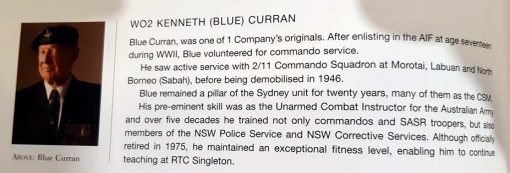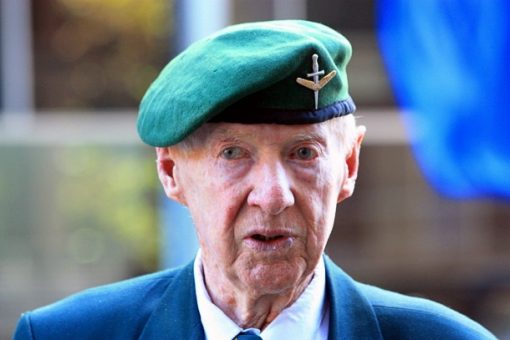Kenneth Roy CURRAN OAM
Kenneth Roy CURRAN OAM
AKA Bluey
Late of Frenchs Forest, NSW
NSW Redfern or Penrith Police Academy Class # ? ? ?
New South Wales Police Force
Regd. # ????
Rank: ?
Final Rank = ?
Stations: ?
Service: From ? ? 1950 to ? ? 1956 = 6 years Service
Awards: Medal of the Order of Australia ( OAM ) granted 12 June 2006
For service to the community, particularly through pipe bands & aged care organisations, & to a range of military and law enforcement authorities as an instructor.
Born: Wednesday 9 September 1925
Died on: Thursday 27 June 2019
Age: 93yrs 9mths 18days
Cause: On 24 May 2019 – Ken was in Arcardia, Pittwater Private Hospital after a heart attack
Event location: ?
Event date: ?
Funeral date: Thursday 4 July 2019 @ 10.30am
Funeral location: St. Martin de Porres Catholic Church, Prahran Avenue, Davidson, NSW
Wake location: ?
Funeral Parlour: Ann Wilson Funerals – 02 9971 4224
Buried at: ?
Memorial located at: ?
In the 1954 Electoral rolls, Ken is living at 91 Connaught St, Dee Why – along with Dory Mary, who was possibly his wife – and his occupation is recorded as ‘Policeman’.
Norma ( dec ), mentioned in his obituary “may have been” his second wife.
Cal via Kevin Banister.
BLUEY is NOT mentioned on the Police Wall of Remembrance * NOT JOB RELATED
FURTHER INFORMATION IS NEEDED ABOUT THIS PERSON, THEIR LIFE, THEIR CAREER AND THEIR DEATH.
PLEASE SEND PHOTOS AND INFORMATION TO Cal
May they forever Rest In Peace

NX202327
1st Commando Company
“BLUEY”
Aged 93
Late of Frenchs Forest Passed away peacefully 27 June 2019
Dearly loved husband of Norma (dec).
Adored father of Neville, Graeme, Jenny and their partners.
Devoted Pop of seven grandchildren and ten great-grandchildren.
Loved by all his family.
In God’s Care
A Requiem Mass for the repose of the soul of Ken will be held at St. Martin de Porres Catholic Church, Prahran Avenue, Davidson on Thursday, 4 July, 2019 at 10.30am.
By request no flowers please
Publication: Manly Daily
IF, you’ve ever published a death notice of some significance, this is it.
Ken Curran was a Commando during his military service. I am not sure whether he served in WW2, Korea, Vietnam….? But, I can gain more for you later.
Ken Curran was in my Unit, 1/19 Bn RNSWR and he was a fine man. He gave his all to those about him.
A true ‘Serviceman’. One, that I respected and admired.
Sadly, I am in Tasmania for the moment, and thus won’t be in a position to be at his funeral………. bugger.
Bob Burrage.


Ken Blue Curran (2012)
Inducted into the A.M.A.H.O.F.(Inc) for 2012
Lifetime Achievement – Army Unarmed Combat
Inducted into the W.K.U.H.O.F. for 2012
Lifetime Achievement – Army Unarmed Combat

Kenneth Roy “Blue” Curran was born on 9th September 1925 in Waverly NSW. He first joined the army during WW II in 1943 at 18 years of age. His service number was NX 202327 he served in Australia and after reaching 19 years of age and therefore being eligible for overseas operational deployment transferred from Infantry to Commandos. He saw service in 2/11 Cavalry Regiment Commando Squadron, he completed his commando training in far North Queensland and later saw service in Moratai, Labuan, British Borneo and Rabaul before the end of the war.
At wars end he returned to civilian life but reenlisted in the military as a Citizen Military Force (CMF) member of the newly raised 1 Commando Company (1 Cmdo Coy) in 1955 at the age of 30. His CMF service number was 2242907.
Blue was an active member of 1 Cmdo for twenty years up until 1975 when he officially retired from military service. However, as a result of Blue’s experience and skills relating to Military Unarmed Combat (MUC) training over the years he has been retained as a consultant from time to time to the military to assist in MUC training well into the new millennia.
As a consultant to the military he had conducted training for commandos, infantry battalions and other unit’s right through to 2000. From 2004 to 2007 he was requested by the Infantry Training Center at Ingleburn to conduct training in bayonet fighting. In addition to his service to the military Blue has also trained the first members of the then newly raised NSW Police Tactical Response Group (TRG) and continued to provide training support as requested. He has trained numerous other law enforcement groups, prison services and members of the Sheriff’s Department. He has also conducted security training for security firms, and personal self defence training for members of the community. He continues to train security officers in self defence and the use of batons and handcuffing techniques.
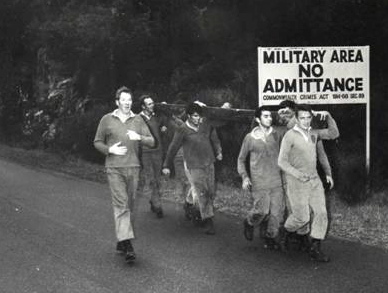
During his time in the Australian Military Blue was responsible for keeping alive MUC from his initial training in WW II to its resurgence in the mid 1950’s with the raising of 1 Cmdo Coy. He was also instrumental in the continual review and development of the MUC training program ensuring that outdated techniques were dropped from the syllabus and new information added to keep the MUC syllabus relevant to the changing needs of the military. This also comprised the inclusion of skills from civilian martial arts either through serving soldiers with previous experience or through association with martial arts instructors. However, it was always advocated that any changes to the syllabus was relevant to the operational requirements of the military and were not a stylised application of complicated techniques that did not fit military needs or application.
Blue over time would later become the Army’s senior MUC instructor and the person primarily responsible for its propagation to the next generation of MUC instructors in the early to mid 1960’s who in later years would guide MUC within the military. In this role Blue was the last then serving WWII Commando with MUC training and operational experience remaining from the WW II era. Those instructors who later would have their own significant contributions to MUC that would benefit from this knowledge and experience included Major Greg Mawkes, Major John Whipp, and WO1 Denis Gaskell to name a few.
In 1980 Blue was officially acknowledged for his services related to MUC training within the military and was awarded the Order of Australia Medal. In later years he was recognized further by membership to the International Close Quarter Fighting Instructors Association. Ken currently lives with his wife in French’s Forrest Sydney.
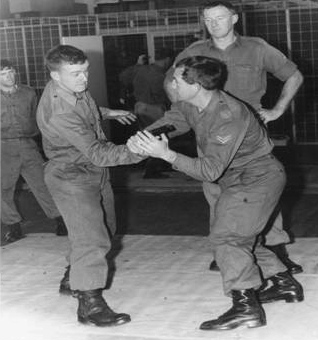
Dialogue and Interview with Ken “Blue” Curran OAM, JP
Recorded by Glen Gardiner 1st April 2010, Sydney
I first joined the army in 1943 when I was 18 years old. I went to recruit training in Warwick in Queensland and returned to Sydney where I was posted to a young soldier infantry battalion.
At that time you could not be deployed overseas on operations until you were 19 years of age. So those of us who were under 19 years of age would end up in these young soldier battalions. There were three of these battalions located in Sydney at the time.

While posted to Sydney I was involved in the development of beach defences in and around Sydney. I attended my first Military Unarmed Combat (MUC) course in Sydney which was run by an ex professional wrestler named Alf Vockler. He was a Warrant Officer 2nd Class (WO 2) and the only instructor on the course. In those days MUC was virtually unheard of. To the best of my memory he was posted to the military as a Sgt because of his wrestling experience. He may have come from a corps of instructors but I am not certain.
The MUC course was conducted in the French’s Forrest area at Terry hills around the Xmas period of 1943/1944. The course duration was for a period of 2 weeks, the courses official title was Physical Training and Unarmed Combat Course. There were approximately 20 participants on the course from the infantry corps. To my knowledge all passed the training and qualified as an exponent. In those days the army did not run instructors courses that I am aware of and relied on military personnel with previous experience recruited specifically to instruct.
The training consisted mostly of holds and restraints with a heavy focus on wrestling. There was a little bit of disarm techniques related to pistols. Not much was done with rifles or knives even. Counters to open handed attack with the counters mainly being throw downs was also conducted. There was a very heavy amount of work related to physical fitness training.
Later that year after completing the MUC course I was sent to Cowra as a reinforcement when Japanese POW’s made an attempt to escape. After that I returned to Sydney where I turned 19 and was then sent to Canungra. The course at Canungra was jungle training before we were deployment north on operations. After completing training at Canungra I and 3 others volunteered to be transferred from infantry to Commandos. 3 of us were accepted into 2/11 Commando Cavalry Squadron. This unit had formally been a cavalry unit in the Middle East with the 9th Division prior to their return to Australia. From Canungra I was posted to the Atherton Tablelands with 2/11 Commando Sqn (Divisional Commando with 3 Commando units attached to each Division) at Raven hoe where we conducted pre deployment training. We concluded commando training here in 1944. It included infantry training, MUC, explosives training, etc.
I was used to conduct the MUC training as an instructor for the unit as I was the only one in the unit who had done an MUC course that I was aware of. During this period at Raven hoe which was only several months. During this time I trained the personnel in platoon sized groups. I think would have trained 2 platoons in this period. It was difficult to train more or formalize the training as in those days the members of the unit were scattered all over the place conducting various forms of training before deployment. This was all prepatory to us doing invasion training which was later conducted near Cairns if my memory is correct. Members of the unit would conduct training at the Atherton Tableland and then go to Cairns to do training changing from ships to landing craft, cargo nets and practicing beach landings. The troops would then return to the tableland and do other forms of training some of which included MUC depending on availability. We then were deployed in the invasion of Moratai in 1944 (2/11 Cmdo Cav Regt, 24 Bde, 9 Div). After Moratai we boarded steamers and conducted the invasion of Labuan (1944). After the capture of Labuan we were deployed to British Borneo, Papar on the Padus River pushing up the rail link to Jesselton. While we were in Jesselton we received news that the war was over.
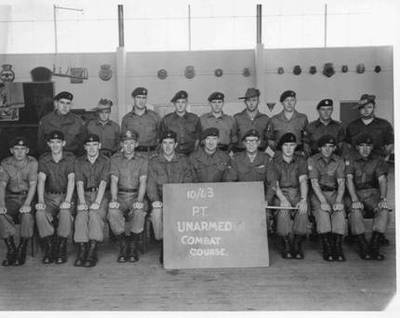
The 2/11 Cmdo Cav Regt was disbanded and I was sent to Rabaul for several months guarding prisoners as well as being involved in infrastructure rebuilding. I then returned to Australia and after a period when I was hospitalised with malaria I was demobed at the School of Artillery at North Head after I had recovered from my bout of malaria.
After the war I completed my apprenticeship as a photo engraver and joined the NSW police force from 1950 to 1956. I then worked for the NSW railway as a fireman on the steam engines for a year. I then returned to my trade. During my working life I did a lot of different jobs.
In 1955 I joined the Citizen Military Forces (CMF) the pre cursor to the Reserves. I did my CMF recruit course at 1 Commando Company at Georges Heights, Mossman. I remained in that unit until 1975. During this period I instructed MUC courses for the unit and other members of the Army. The chief instructor for MUC training at 1 CMDO at this time was WO 2 Lionel Currell (“PUP” Currell).

It was during this period that I requalified as a MUC exponent and later qualified as an Instructor. During my time with Commandos I later assumed the position of chief instructor teaching MUC at 1 Commando. WO 2 Lionel Currell was a regular army soldier and a WW II commando veteran. When I joined 1 Cmdo, he was the 1 Cmdo Coy, Company Sergeant Major (CSM). He was posted to the unit from Western Australia where he was involved in a parachute unit. I have no idea where he learnt MUC but he was very proficient, a disciplinarian and I was his assistant instructor. After his 4 year posting to the unit he was reposted and I became the senior instructor for 1 Cmdo Coy. Prior to his leaving I had risen through the ranks and I was promoted to the position of CSM 1 Cmdo Coy, the first CMF member to reach this position. The Officer Commanding (OC) of 1 Cmdo Coy during this time was a regular army officer, Major Grant, a veteran of WWII and Korea who was later promoted to Brigadier and an ex WWII Commando. He is now living in Melbourne I believe.

During my time with 1 Cmdo I trained many units over the years in MUC. I trained the Special Air Service Regiment (SASR) on 4 occasions in Perth as well as their members at 1 Cmdo Coy. The majority of SAS instructors came from 1 and 2 Cmdo with a lot of their first members coming from these units as well. I also gave training to 3rd battalion Royal Australian Regiment (3 RAR) and the 1/19 battalion CMF Bushman’s Rifles at Ingleburn.
It is hard to remember all the courses I instructed on. A lot of the courses would be conducted at 1 Cmdo Coy. After I retired from the CMF in 1975 I would still be asked to conduct MUC courses for my old unit and others. In 2004 I was called by Major Davis at Singleton to teach bayonet work in trenches. I did this as a volunteer for a period of 3 and half years.
I think while I was at 1 Cmdo I ran approximately 2 courses a year from 1955 to 1975. In addition to this I was also involved in conducting training for police instructing the first course for the NSW police Tactical Response Group (TRG) at 1 Cmdo Coy. In subsequent years I conducted follow up training with the police as well as the NSW prisons department and later the Corrective Services, Australian Protective Services, and Sheriff’s Department. I have also conducted numerous self defence and training courses for commercial security personnel in the security industry. I am currently 84 years young and still conducting self defence and security officer training teaching self defence, batons and handcuffing techniques.
“Blue”, who were the Instructors of MUC and what was their backgrounds when you first started training and then through your subsequent time teaching MUC?
The first MUC instructor I met was WO 2 Alf Vockler who was a professional wrestler. As a young digger this man was god to us. I believe he had joined and was recruited by the military to teach MUC. Later in the 1950’s while at 1 Cmdo Coy I met WO 2 Lionel Currell who was the senior instructor for MUC at 1 Cmdo Coy before being posted from the unit. I am not sure where he learnt MUC but he was quite good at it. I believe Lionel was initially trained possibly by British instructors. I am not aware if he had previous training in martial arts other than MUC. I remember that he was a strong disciplinarian.

To your knowledge “Blue” was MUC also being trained in other non commando units and was it widespread in the Army as well as other services during WWII?
I am not certain about that because during this time you only new about what your particular mob was doing. But thinking about it, it is quite possible that this was the case.
After World War II can you describe the attitude toward MUC training by the military command in commandos and the wider military?
After WWII MUC training disappeared within the Australian military. It did not gain resurgence until the formation of the CMF commandos in 1955.
Senior military commanders had lost touch with MUC and felt that it was a specialist skill and not something that was regularly conducted within the wider Army. It was thought of as being more relevant for Special Forces (SF). However, non SF units would contact 1 Cmdo Coy requesting this form of training.
“Blue”, was there a resurgence of MUC training with the onset of the Korean War and if so who were the instructors and where were the courses conducted and what did the syllabus contain?
I am not sure if MUC was taught for the Korean War but it was 1 and 2 Cmdo Coy which revitalized MUC in the Australian army from the mid 1950’s. In 2 Cmdo Coy the main Instructor was Ted Malone. I also qualified Major Greg Mawkes from the SASR in Swanbourne in the 1960’s. He later became OC of 2 Cmdo Coy and then was responsible for MUC training in the SASR.
John Whipp was another instructor qualified by me in 1962 prior to going to Vietnam. He was in an infantry battalion at the time and did the course at 1 Cmdo here in Sydney. John and Greg would both later play important roles in MUC training within the Australian military.
During this period the syllabus for MUC had changed dramatically to that of WWII. The main emphasis now was on killing techniques. This was developed through seeing what was being done in military circles as well as civilian martial arts and then adapting that information for the various roles required in the military. The courses were continually updated for current techniques of the day with the syllabus still displaying a strong emphasis on physical training, rolls and break falls, pressure points, throws, striking techniques, defence against weapons including firearms, knives, machetes, bayonet fighting, elimination techniques and prisoner control.

“Blue”, did you feel that the support for MUC by the military command was cyclic and stop and go during your years of association with MUC training?
Yes support for MUC in the Australian military was very up and down dependent on the individual interest of senior commanders within the army. Some military commanders understood the value others did not and MUC either benefited or not from this situation.
The problem was however, that after a period of non support the Army would need to re-invent the wheel again and had to either find remaining qualified personnel or start again. I think the cycle now is going downhill once again after some support in recent years.
“Blue”, was there a renewal and subsequent wane of interest in MUC in the Vietnam War era?
Prior to going to Vietnam there was interest by personnel to conduct training however, this conflicted with the need for unit commanders to train troops prior to deployment in normal infantry soldier skills and not ones seen as value added such as MUC.
“Blue”, do you feel that MUC in the Australian military developed in different directions as members of the defence force promoted MUC in the Army as well as the other services for different needs, what can you tell us about this?
Yes I did see MUC go in different directions, but I still think that MUC should be under one banner with different corps requirements being managed under one guiding direction. Each one has its own core requirement but needs to be managed so that MUC heads in one direction; to make my point Military Police don’t need to be taught how to kill for example. But they also need to know techniques for an operational focus.
“Blue”, during the period that you have been involved with MUC training in the military have you seen it evolve and if so what are your thoughts about that evolution?
Yes, MUC has evolved and I think for the best as new techniques are added that support the soldiers role for today.
“Blue”, in your opinion do you feel that there is still a place for MUC training in the military in the 21st century and if so what it is?
Yes, without a doubt. MUC is required to enable our Army to stay relevant with other nations and to develop soldierly skills and techniques that are required on operations.
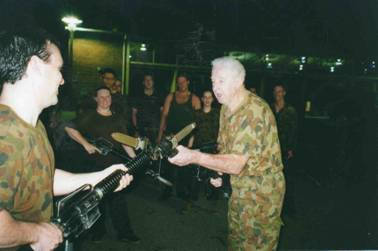
“Blue”, what is your opinion concerning the military sourcing civilian martial artists to teach soldiers, do you think it relevant and are these instructors suitable to teach for various operational roles?
I maintain that an instructor needs to have a military background but it is commonsense to take knowledge from wherever we can find it and adapt it for the military role. You must update to stay current. I don’t think civilian instructors though are the complete answer. But certainly take the knowledge and adapt it for the military using military instructors or previous civilian instructors who are in the military.
“Blue”, in your opinion what do you feel would be the way forward for MUC training today for today’s military?
Training needs to be relevant to the needs of the Army, it is unfortunate that currently MUC in today’s military is not as widespread throughout the military as it should be as in other nations. I think that it is difficult for military commanders to recognize the value of MUC and to support MUC. Until this happens MUC will remain as it always has and will be reliant on the support of individual commanders as they come and go. In today’s Army MUC should be integral in training developing skills and confidence.
“Blue”, can you describe what the training was like? How hard? Injury rates etc
Injury rates in the WWII MUC courses were very low and the same applied during my time teaching MUC. High injury rates are a sign of bad instruction. Training was hard, we had to prove a point, and a lot of the techniques were designed for killing. Physical fitness was a big part of training, it was important to teach soldiers to develop the will to still keep going. It still is important.
“Blue” you have lived to a very fortunate age what pearls of wisdom can you impart to the younger generations on conducting self defence/defensive tactics training?
As is, Keep it up and keep it going, it is something that is needed. Use commonsense, make sure there are no injuries and impart knowledge as best you can.
“Blue” what advice would you give people regarding avoiding fights and once in a fight what should they do?
Walk away from it if possible, if you cannot walk away you have to do the best you can. If you are in it you are in it to win. I don’t care if I have to use dirty tactics to win and survive.
“Blue”, what are your views of the Australian soldier from when you were serving and the current Aussie soldier today?

I think today they are far superior to the soldier of the past. The soldier of the past came up through the depression days. He had to learn the ropes the hard way. Today’s young soldiers in my opinion are far better educated and sophisticated and willing to learn. A far better type of lad mentally and physically to previous years. As an example one participant as a private learning MUC was a qualified medical doctor and he had a genuine desire to learn.
